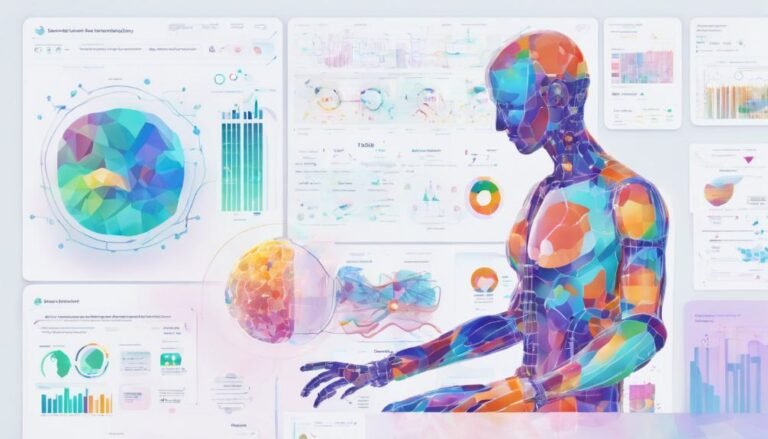AI in Emergency Medicine
Imagine the delicate balance between human expertise and artificial intelligence in the high-stakes setting of emergency medicine. As AI continues to evolve and integrate into healthcare systems, it prompts a critical question: how will this impact the traditional roles of emergency healthcare providers and the quality of care delivered to patients in urgent situations? The intersection of technology and medicine opens up a domain of possibilities, challenging established norms and reshaping the future of emergency medical practices.
Key Takeaways
- AI enhances diagnostic accuracy and efficiency in emergency medicine.
- Streamlined treatment protocols optimize patient care with AI integration.
- Improved patient outcomes through faster diagnosis and personalized treatment.
- Resource optimization and predictive analytics improve emergency healthcare delivery.
- Risk stratification aids in prioritizing patient management for better outcomes.
AI-enhanced Diagnostics
Utilizing AI technology in emergency medicine can greatly enhance diagnostic accuracy and efficiency, ultimately improving patient outcomes. Automation plays a vital role in streamlining the diagnostic process, allowing for faster and more precise identification of conditions.
Through clinical decision support systems, AI can analyze vast amounts of patient data in real-time, aiding healthcare providers in making accurate diagnoses promptly. The seamless integration of AI technology into existing emergency medical systems enables healthcare professionals to access advanced tools that augment their decision-making process.
Streamlined Treatment Protocols
Enhancing emergency medicine with AI involves streamlining treatment protocols to optimize patient care and outcomes. Protocol optimization through AI integration allows for efficient triaging, diagnosis, and treatment recommendations tailored to individual patient needs.
By harnessing the power of artificial intelligence, emergency medical teams can expedite decision-making processes, ensuring timely interventions and reducing treatment delays.
Efficiency enhancement is a key benefit of utilizing AI in treatment protocols. AI algorithms can analyze vast amounts of patient data in real-time, identifying patterns and trends that may not be immediately apparent to human providers. This capability enables healthcare professionals to make well-informed decisions quickly, leading to improved patient outcomes and increased survival rates in critical situations.
Moreover, AI streamlines communication between healthcare teams, facilitating seamless coordination and collaboration in emergency settings. By automating routine tasks and providing evidence-based guidelines, AI empowers medical staff to focus more on direct patient care, ultimately enhancing the overall efficiency and effectiveness of emergency medical services.
Improved Patient Outcomes
As you explore the world of AI in emergency medicine, it's vital to recognize the profound impact it has on patient outcomes.
With AI's assistance, you can experience faster diagnosis accuracy leading to more precise treatment decisions.
Additionally, the integration of preventative care strategies can greatly enhance patient well-being and recovery rates.
Faster Diagnosis Accuracy
With the integration of AI technology in emergency medicine, rapid and accurate diagnosis is essential for enhancing patient outcomes. Machine learning algorithms play an important role in achieving faster diagnosis accuracy, allowing healthcare providers to make informed decisions promptly. These algorithms analyze vast amounts of patient data, including symptoms, medical history, and test results, to assist in identifying potential conditions more efficiently than traditional methods.
By leveraging machine learning, emergency departments can improve diagnostic accuracy, leading to quicker intervention and treatment initiation. This not only enhances patient outcomes but also contributes to reducing healthcare costs and hospital stays. The ability of AI to recognize patterns and trends in data enables healthcare professionals to diagnose conditions accurately and swiftly, ultimately saving lives in critical situations.
In emergency medicine, where time is of the essence, the implementation of AI-driven diagnostic tools can have a significant impact on patient care. By ensuring faster and more accurate diagnoses, healthcare providers can deliver timely interventions, improve patient outcomes, and enhance overall quality of care.
Enhanced Treatment Decisions
To make informed treatment decisions that lead to improved patient outcomes, AI technology offers valuable support in emergency medicine. Treatment optimization is an important aspect of patient care, and AI excels in analyzing vast amounts of data to assist healthcare providers in making the best decisions.
By leveraging AI for data analysis, healthcare professionals can receive decision support based on clinical guidelines and real-time patient data.
AI technology can help streamline the treatment decision-making process by providing insights into the most effective interventions for individual patients. Through sophisticated algorithms, AI can identify patterns in patient data and recommend personalized treatment plans tailored to each unique case.
This level of personalized decision support can greatly enhance patient outcomes by ensuring that treatments are optimized and aligned with evidence-based practices.
In emergency medicine, where quick and accurate decisions can be a matter of life and death, AI's ability to analyze data and provide decision support based on clinical guidelines is invaluable.
Preventative Care Strategies
Implementing preventative care strategies is crucial in emergency medicine to enhance patient outcomes and overall well-being. One way AI can assist in this is through remote monitoring, allowing healthcare providers to track patients' vital signs and health metrics continuously. By utilizing AI algorithms to analyze this data, potential health issues can be identified early, enabling timely interventions and preventing emergencies.
Moreover, AI can recommend personalized lifestyle interventions based on patient data and trends. These interventions may include dietary recommendations, exercise plans, or stress management techniques tailored to individual needs. By promoting healthier habits and behaviors, the risk of emergencies related to chronic conditions can be reduced significantly.
Incorporating preventative care strategies supported by AI technology not only improves patient outcomes but also enhances the efficiency of emergency medical services. It empowers patients to take an active role in managing their health and well-being, ultimately leading to a healthier population and a more proactive approach to emergency medicine.
Triage and Resource Allocation
When utilizing AI in emergency medicine, you can enhance triage efficiency by swiftly identifying the importance of each patient's condition.
By incorporating AI algorithms, you can optimize the allocation of vital resources such as hospital beds, medical staff, and equipment, ensuring that each patient receives timely and appropriate care.
Implementing AI technology in triage and resource allocation processes can greatly improve patient outcomes and streamline emergency department operations.
AI for Triage Efficiency
Utilizing AI algorithms in emergency medicine can greatly enhance triage efficiency by swiftly and accurately prioritizing patients based on severity levels, optimizing resource allocation, and ultimately improving patient outcomes.
Triage automation, through the use of AI algorithms, streamlines the process by quickly evaluating patients upon arrival, guaranteeing that those in critical condition receive immediate attention. This leads to reduced wait times for all patients and allows for timely interventions where needed. Patient prioritization becomes more precise as AI can analyze vast amounts of data in real-time, helping medical staff make informed decisions promptly.
In emergency room settings, AI contributes to overall efficiency by allocating resources effectively based on the severity of cases. This optimized resource allocation ensures that critical patients receive the necessary care without delays, potentially saving lives. By automating triage and enhancing patient prioritization, AI not only improves emergency room workflow but also enhances the quality of care provided to patients during pivotal moments.
Resource Optimization With AI
Enhancing emergency medical resource optimization can be facilitated through the integration of AI technologies, particularly in the areas of triage and resource allocation. AI can assist in staff scheduling by predicting patient influxes and adjusting schedules accordingly, ensuring adequate coverage during peak times.
By analyzing historical data, AI can also optimize equipment utilization, predicting which resources will be needed most frequently and when, reducing unnecessary downtime and ensuring efficient equipment allocation.
Furthermore, AI can improve patient flow by predicting the severity and needs of incoming patients, allowing for better allocation of resources and reducing wait times. By streamlining triage processes through AI-powered algorithms, patients can be directed to the appropriate level of care more quickly, leading to improved outcomes and overall satisfaction.
Predictive Analytics
By analyzing historical patient data, predictive analytics assists emergency medicine professionals in anticipating patient outcomes and making informed decisions for best care. Through data mining, patterns and trends can be identified, enabling healthcare providers to predict potential outcomes based on past cases. Machine learning algorithms play a vital role in this process, continuously improving their accuracy in predicting patient trajectories.
These predictive analytics tools not only help in forecasting patient outcomes but also aid in clinical decision-making. By analyzing a vast amount of patient data, emergency medicine professionals can make more informed decisions regarding treatment plans, resource allocation, and patient management. This data-driven approach enhances the efficiency and effectiveness of care delivery in emergency medicine settings.
Incorporating predictive analytics into emergency medicine practices allows for a proactive rather than reactive approach to patient care. By leveraging technology to anticipate potential outcomes, healthcare providers can better tailor their interventions and improve patient outcomes.
Risk Stratification
To effectively manage patient care in emergency medicine, understanding and implementing risk stratification methodologies is essential. Risk stratification involves the analysis of patient data to identify individuals at higher risk of adverse outcomes. Through advanced data analysis techniques, such as machine learning algorithms, healthcare providers can categorize patients based on the likelihood of certain events, allowing for personalized and targeted patient management strategies.
By utilizing data analysis, emergency medicine teams can prioritize resources and interventions for patients who require immediate attention or specialized care. This approach optimizes patient management by ensuring that those at higher risk receive the necessary treatments promptly, potentially improving outcomes and reducing complications.
Risk stratification not only enhances clinical decision-making but also supports healthcare professionals in making more informed choices regarding patient disposition, resource allocation, and follow-up care. By incorporating data-driven risk assessment into emergency medicine practices, providers can deliver more efficient and effective care tailored to each patient's specific needs.
Future of Healthcare Delivery
The future of healthcare delivery involves leveraging cutting-edge technology to streamline processes and enhance patient outcomes. Remote patient monitoring and telemedicine integration are revolutionizing the way healthcare is provided, allowing for continuous monitoring and care outside traditional healthcare settings. This advancement enables healthcare professionals to track essential signs, manage chronic conditions, and intervene promptly when needed, ultimately leading to improved patient well-being and reduced hospital admissions.
Moreover, personalized medicine and precision healthcare are reshaping the landscape of patient treatment. By tailoring medical decisions and interventions to individual characteristics such as genetics, lifestyle, and environmental factors, healthcare providers can deliver more effective and targeted care. This approach not only enhances treatment efficacy but also minimizes adverse reactions and unnecessary treatments.
Conclusion
As you gaze into the horizon of emergency medicine, AI stands as the guiding lighthouse, illuminating the path towards faster diagnoses, personalized treatments, and improved outcomes.
Like a skilled navigator, AI steers healthcare providers towards efficient resource allocation, informed decision-making, and predictive insights.
Embrace this technological ally, for it's the compass leading us towards a brighter, healthier future in emergency care.
Let AI be your guiding star in the ever-evolving journey of healthcare delivery.







